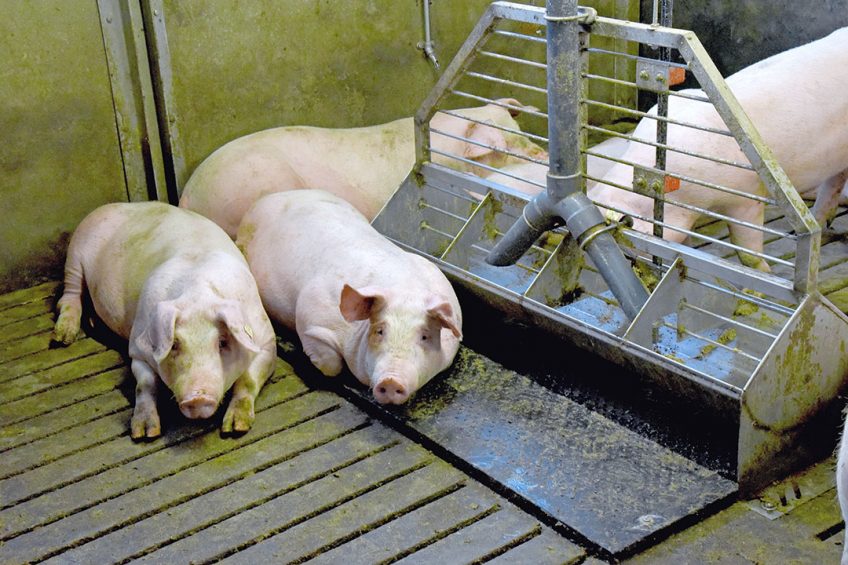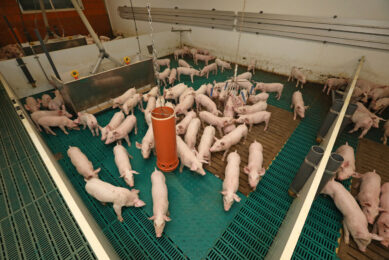Water-to-feed ratios in growing-finishers

Interest in giving pigs wet feed has increased in recent decades, especially in Europe. There are still many unanswered questions about how to do this most efficiently. For instance: how much does the water-to-feed ratio matter in terms of the digestibility of energy and nutrients?
A study of water-to-feed ratios in growing-finishing pigs was recently published by Professor Josep Gasa and colleagues at the Autonomous University of Barcelona (UAB) in Spain, including Dr Ramon Muns, who graduated from UAB and now leads the Monogastric Research Group at the Agri-Food and Biosciences Institute (AFBI) in Northern Ireland, UK.
Why is liquid feed popular?
Before looking at the results of this particular study, it is good to quickly recap the topic of liquid feed and why it has become a popular method for feeding pigs in many countries in Europe. In Prof Gasa’s view, one reason for this is the availability of liquid food industry co-products (e.g. from dairy processors), which makes liquid feeding cheaper than other alternatives.
However, he adds, “Co-products vary significantly in composition, and diet formulations need to be reviewed frequently. Also, in hotter months in warmer regions, for example Mediterranean countries, it is crucial to pay attention to the cleanliness and disinfection of liquid feeding systems.”
Liquid feeding involves blending dry feed (a mixture of raw materials “as fed”) with water or a liquid co-product in a central tank before the mixture is pumped to the feeding pens through pipes. It contains about 700–800 grammes of water per kilogramme, and the capacity of the pump and pipes that the feed travels through from the central tank to the feeding pens determines how much dry matter can be added to the mixture, that is, it must be thin enough to be pumped properly.
Study results
In their research, Prof Gasa, Dr Muns and their colleagues found that the optimal water-to-feed ratio for improving organic matter and gross energy digestibility varies according to the age of the animal. “In particular, the water-to-feed ratios that improve digestibility coefficients were lower for young growing pigs and higher for older finishing pigs,” the team states. “The data suggest that optimum efficiency is reached with a less water-diluted diet for young animals, when compared to older pigs.”
Younger pigs have a smaller gut, and the larger volume of a liquid diet can therefore make it difficult for them to consume the amount of dry matter (and therefore absorb enough nutrients) that will result in optimal growth.
Prof Gasa notes that older pigs may produce more enzymes, boosting nutrient absorption. Their stomachs are also more developed, not just larger, making them inherently more able to absorb more nutrients/energy from liquid feed compared to younger pigs with less-developed guts. He concludes that with current technology (a feed kitchen, mixing tanks, pumps and pipes), “it is not clear that using liquid feeding across all stages would be beneficial. For the finishing and gestation stages it’s usually good, but at the nursery and lactation stages it might result in suboptimal intake.”
When he was asked whether the speed of mixing and distributing liquid feed to the pigs could make a difference in pig performance at any age, Prof Gasa said he does not think so. “I do not believe that shortening mixing or distribution time (we would be talking about a difference of ten or maybe 30 minutes) would affect digestibility and intake,” he says.
I would say that about 40% of the fattening houses in Northern Ireland use liquid feeding, and wet/dry is only used at a few farms
Wet/dry systems
At AFBI, Dr Muns has recently been involved in some trials with a newish type of wet/dry feeding system, but wet/dry is also used to refer to feeders that have a water nipple in the trough. “In our system at AFBI, which happens to be made by Spotmix, water and the compound feed are kept separate up to the point of delivery to the feeding trough where they mix to some extent,” he explains.
“This somewhat homogenises a meal diet, but it does notwork as well with pellets. I would say it is closer to liquid feeding because you can have different dilution ratios that are similar to liquid systems.” In their preliminary analysis, Dr Muns and his colleagues have found that feed conversion ratios with their system were similar to dry feeding, but feed intake and growth rate were higher. “I would say that about 40% of the fattening houses in Northern Ireland use liquid feeding, and wet/dry is only used at a few farms,” Dr Muns reports. “I am not sure about the rest of Europe and beyond. Next in our research, we are going to see how much the amount of water added to the dry feed affects feed conversion, feed intake and growth rate, especially in the nursery phase. Another question is whether it’s best to use liquid or wet/dry feeding the whole way from weaning to finishing, or if it’s best to change from dry to wet at some point from a performance and economic perspective.”
Advice to pork producers
In terms of advice to producers who need to make a decision about the type of feeding system to purchase, Dr Muns says that if a farmer has co-products available, a liquid feeding system is the best way to go, particularly if it’s a finishing operation. With finishing pigs, there is more leeway, he notes, in terms of not having to be so precise with quality monitoring and adjustment of liquid feed plus co-product compared to, for example, sows in lactation.
If there are no co-products available to a farmer, however, Dr Muns does recommend a wet/dry system. “You will then have no degradation of ingredients,” he says, “and you will have less maintenance and cleaning of the system compared to a liquid system (less risk of biofilm forming). Also, if a farmer has the type of system we have been using at AFBI, it allows you to choose or swap between dry and wet/dry feeding.”











